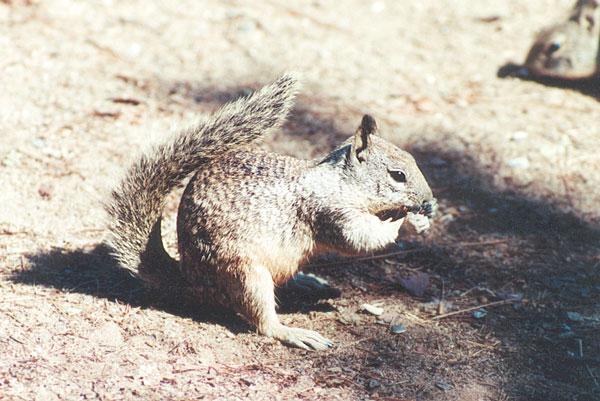|
| Query: sand snake | Result: 3rd of 43 | |
California Ground Squirrel
| Subject: | California Ground Squirrel
| | Poster: | "scarysquirrrel" (skwerl@skwerl.net)
| |

| File size : 53592 bytes
File date : 1999:10:17 09:00:00
Resolution: 600x401
Jpeg process : Baseline
Posted Newsgroups: alt.binaries.pictures.animals
Posted Date: Sat, 16 Oct 1999 22:50:49 -0700 |
ERROR : Server Busy(-1105)
ERROR : Server Busy(-1105)
California Ground Squirrel
http://www.scarysquirrel.org
ground2.jpg
|
Comments |
|---|
| | News |
|
Squirrels use infrared against snakes
Heated tail display warns off would-be predators.
16 June 2004
MICHAEL HOPKIN
From the 41st Animal Behavior Society meeting, Oaxaca, Mexico.
The squirrels are the first species found to use heat as a deliberate signal.
Faced with an angry rattlesnake, you or I might freeze with fear. But California ground squirrels take the opposite approach: they heat their tails up to warn the snake that they will not take an attack lying down.
It is the first time that an animal has been shown to send a deliberate signal using infrared radiation, or heat, says Aaron Rundus of the University of California, Davis, who presented the discovery on Monday at the Animal Behavior Society's annual meeting in Oaxaca, Mexico.
Rattlesnakes are a constant menace to the squirrels, often poaching young from families. This threat gives rise to aggressive stand-offs between snakes and adult squirrels, in which the rodent kicks sand and brandishes its tail in a bid to harass the predator into submission.
The snakes do much of their hunting by detecting heat, using sensitive structures called pit organs in their faces. The new discovery shows that the squirrels take advantage of this sensitivity by broadcasting their message in a language the snakes can understand.
Getting warmer
Rundus placed wild-caught squirrels in a cage with a rattlesnake and filmed the resulting show-down using an infrared camera. As the squirrel whipped its tail threateningly back and forth, the appendage grew warmer.
The squirrels achieve the effect by making their tail fur stand on end to expose more skin, and perhaps by dilating blood vessels near the tail's surface, Rundus told the meeting. Furthermore, the squirrels' tails did not heat up when caged with a gopher snake, a predator that lacks pit organs. This shows that the squirrels can recognize different predators and respond accordingly.
"I think it's absolutely intriguing," says Jim Hare, who studies ground squirrels at the University of Manitoba in Winnipeg, Canada. "I had no idea at all that they were doing that." He adds that ground squirrels are known to respond differently to a range of predator types when giving warning calls to their fellows.
Roll on robo-squirrel
The heat signal could function to distract the snake's attention from vulnerable young, Rundus suggests, or simply as an indicator of the adult's presence. However, the squirrels are not entirely gung-ho; although rattlesnakes rarely eat adults, a fight could easily lead to death or serious injury.
Rundus wants to manipulate the effect to see whether snakes respond differently to non-heated squirrels. But this is not as easy as it sounds. "I tried everything: insulation, even injections," Rundus recalls. "But it's hard not to affect the behaviour as well."
To this end, he has designed 'robo-squirrel', a stuffed squirrel with a heating element in its tail. "It's nearly ready to go," he says. "We'll just have to see if we get good data."
?? Nature News Service / Macmillan Magazines Ltd 2004
http://www.nature.com/nsu/040614/040614-3.html |
^o^
Animal Pictures Archive for smart phones
^o^
|
|
|

